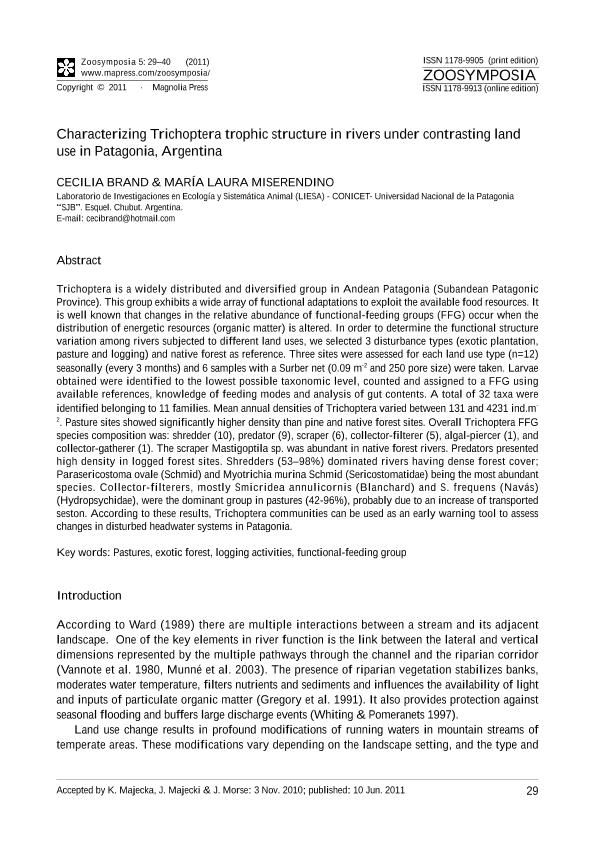Mostrar el registro sencillo del ítem
dc.contributor.author
Brand, Cecilia

dc.contributor.author
Miserendino, Maria Laura

dc.date.available
2019-09-09T21:20:34Z
dc.date.issued
2011-06
dc.identifier.citation
Brand, Cecilia; Miserendino, Maria Laura; Characterizing Trichoptera trophic structure in rivers under contrasting land use in Patagonia, Argentina; Magnolia Press; Zoosymposia; 5; 6-2011; 29-40
dc.identifier.issn
1178-9913
dc.identifier.uri
http://hdl.handle.net/11336/83221
dc.description.abstract
Trichoptera is a widely distributed and diversified group in Andean Patagonia (Subandean Patagonic Province). This group exhibits a wide array of functional adaptations to exploit the available food resources. It is well known that changes in the relative abundance of functional-feeding groups (FFG) occur when the distribution of energetic resources (organic matter) is altered. In order to determine the functional structure variation among rivers subjected to different land uses, we selected 3 disturbance types (exotic plantation, pasture and logging) and native forest as reference. Three sites were assessed for each land use type (n=12) seasonally (every 3 months) and 6 samples with a Surber net (0.09 m-2 and 250 pore size) were taken. Larvae obtained were identified to the lowest possible taxonomic level, counted and assigned to a FFG using available references, knowledge of feeding modes and analysis of gut contents. A total of 32 taxa were identified belonging to 11 families. Mean annual densities of Trichoptera varied between 131 and 4231 ind.m-2. Pasture sites showed significantly higher density than pine and native forest sites. Overall Trichoptera FFG species composition was: shredder (10), predator (9), scraper (6), collector-filterer (5), algal-piercer (1), and collector-gatherer (1). The scraper Mastigoptila sp. was abundant in native forest rivers. Predators presented high density in logged forest sites. Shredders (53–98%) dominated rivers having dense forest cover; Parasericostoma ovale (Schmid) and Myotrichia murina Schmid (Sericostomatidae) being the most abundantspecies. Collector-filterers, mostly Smicridea annulicornis (Blanchard) and S. frequens (Navás)(Hydropsychidae), were the dominant group in pastures (42-96%), probably due to an increase of transported seston. According to these results, Trichoptera communities can be used as an early warning tool to assess changes in disturbed headwater systems in Patagonia.
dc.format
application/pdf
dc.language.iso
eng
dc.publisher
Magnolia Press

dc.rights
info:eu-repo/semantics/openAccess
dc.rights.uri
https://creativecommons.org/licenses/by-nc-sa/2.5/ar/
dc.subject
Pastures
dc.subject
Exotic Forest
dc.subject
Logging Activities
dc.subject
Functional-Feeding Group
dc.subject.classification
Ecología

dc.subject.classification
Ciencias Biológicas

dc.subject.classification
CIENCIAS NATURALES Y EXACTAS

dc.title
Characterizing Trichoptera trophic structure in rivers under contrasting land use in Patagonia, Argentina
dc.type
info:eu-repo/semantics/article
dc.type
info:ar-repo/semantics/artículo
dc.type
info:eu-repo/semantics/publishedVersion
dc.date.updated
2019-08-27T18:45:54Z
dc.identifier.eissn
1178-9913
dc.journal.volume
5
dc.journal.pagination
29-40
dc.journal.pais
Nueva Zelanda

dc.journal.ciudad
Auckland
dc.description.fil
Fil: Brand, Cecilia. Consejo Nacional de Investigaciones Científicas y Técnicas; Argentina. Universidad Nacional de la Patagonia "San Juan Bosco". Facultad de Ciencias Naturales - Sede Esquel. Departamento de Biología. Laboratorio de Investigaciones en Ecología y Sistemática Animal; Argentina
dc.description.fil
Fil: Miserendino, Maria Laura. Consejo Nacional de Investigaciones Científicas y Técnicas; Argentina. Universidad Nacional de la Patagonia "San Juan Bosco". Facultad de Ciencias Naturales - Sede Esquel. Departamento de Biología. Laboratorio de Investigaciones en Ecología y Sistemática Animal; Argentina
dc.journal.title
Zoosymposia
dc.relation.alternativeid
info:eu-repo/semantics/altIdentifier/url/https://www.mapress.com/j/zs/article/view/zoosymposia.5.1.3
Archivos asociados
